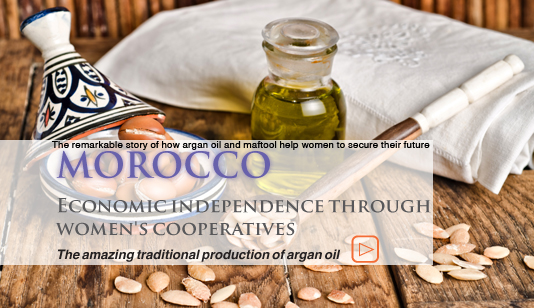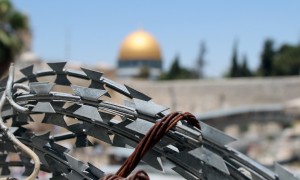MOROCCO
Economic independence through women‘s cooperatives
The amazing traditional production of argan oil
Many international and local organisations encourage and support women’s cooperatives in the southern regions of Morocco – a particularly poor area. Professor Zoubida Charrouf, of Mohammed V University, was one of the first women to establish women’s cooperatives in Agadir. One of her main objectives was to find suitable, sustainable work for mostly un-educated Berber women. There are more than 5,000 women working in more than 170 cooperatives across the country. A CNN report highlighted that 60,000 trees are planted each year to cope with the increasing demand for what is known as ‘golden oil’. Production of the oil should increase annually from approximately 2,500 to 4,000 tonnes by 2020.
Moroccan cooperatives were establish under Fair Trade rules, as women found that they aligned with their main objectives:
The first is to secure an income-generating source for these women and their families through Fair Trade regulations. Living in marginalised, rural areas along the southern coast of Morocco, where women take full responsibility for the harvest and production of argan oil, in a traditionally male-dominated society, this economic independence has helped many women become more aware of their rights and their children’s rights.
The second is to preserve the traditional production of argan oil.
The third is to preserve the remaining argan forest – now endangered and under the protection of UNESCO. These women are contributing to the re-forestation of this rare tree.
Some sources estimate that there are almost three million people in rural areas whose main income is derived from argan products.
What is the argan tree?
It grows wild in semi-arid soil, its deep root system protecting it against soil erosion and the northern advance of the Sahara.
The Arganeraie Biosphere Reserve covers a vast inter-mountain plain of more than 2,560,000 hectares, bordered by the High Atlas and Little Atlas mountains and the Atlantic Ocean to the west. Argania Spinosa, the 1.5 million-year-old species of the tree, has a lifespan of 150 to 200 years.
How is argan oil produced?
Argan oil is expensive because of its rarity and the length of time it takes to extract it from the tree. Nonetheless, the hands of these Moroccan talented women do not stop. This is their way out to improve their lives in this desert and dry spot of the world.
It’s a long, hard process to extract one litre of pure Argan oil, often using primitive machines,as most of the production process is done manually. It takes at least 20 working hours, a lot of patience and skill, but especially, tremendous reserves of passion for the product as the southern areas of Morocco are very hot and dry and an inhospitable environment for hard manual labour. However, the ambiance whilst the women work is quite festive, with plenty of singing and socialising. This work allows them to leave their homes and learn new things in an area where there are few distractions outside of housework.
How argan oil gets from tree to bottle
Goats on the trees
It’s truly co-operative work between the environment, animals and people. One of the most unusual scenes is to see goats on the argan trees. The trees are hard to climb, but not so for goats who eat the fruits of the argan tree, leaving the hard shell behind with the all important nuts inside. Workers are then able to collect the shells from the ground and send them to the cooperatives.
Pulping the aqua
The argan nut, or aqua, must be pulped to separate the dry exterior pulp from the inside nut. The nut is placed between two stones, with another stone used to prise it open carefully. This is similar to the first step in preparing almonds.
Crushing
This step is done manually, with the argan nuts crushed into a thick paste. This takes a lot of effort and is one part of the process that hasn’t yet been reproduced by machinery to the same quality.
Grinding
This next part of the process sees the paste placed into a stone mill. Argan oil for cosmetic use is processed in a stone mill machine to reduce flavour and make the oil more ‘neutral’.
Mixing the argan paste
The argan paste is hand-mixed using circular strokes. This is really difficult and tiring work to which the women working with argan have become accustomed. The result is a loaf of argan called ‘tazquemout’.
Pressing – nothing is discarded
Similar to the hand extraction of olive oil, the loaf of argan is pressed by hand in order to extract the maximum amount of oil. This is a slow and hard process. The oil is then ready for filtration. After this step, what remains of the loaf is also used, as nothing is wasted from this process. The by-products will go to feed animals – usually the goats – in some way, small remuneration for part of the process and their agility in the argan trees. Alternatively, it can be sold to the cosmetics industry that uses argan extracts in their ingredients (shampoo, creams etc).
Why argan trees, and its oil, are so special
The tree
Argan trees supply traditional medicine and cosmetic sectors.
They also provide food, oil, animal feed, building materials, wood, charcoal, shade and stability for surrounding crops. The nutshells can also be burnt as fuel in the cooking process.
The oil
Argan oil offers great benefits for the skin, hair, body and nails. It reduces wrinkles and softens the skin, two of the main reasons for it’s use by the cosmetic industry.
For hair, it restores shine and helps stimulate growth.
It is high in omega-6 fatty acids and linoleic acid, useful as anti-inflammatory, anti-aging, antioxidant and a great moisturiser for skin.
It contains omega-9 unsaturated fatty acids and vitamin A. The tocopherol content of argan oil (vitamin E) makes it a powerful antioxidant, protecting soft tissue by neutralising the effects of free radicals.
The list seems to get longer the more you ask people in North Africa about it, as this tree also grows well in Algeria. People talk about it as if it were ‘magic oil’, made of gold. But what is certain is that the environment is benefitting from the argan trees being saved, as goats still have branches to climb and fruits to eat. Morocco can stand proud as (almost) the only country to have this unique product. And most importantly, women can earn an income, learn a new skill or life opportunities, and surely create a better life for themselves.


























